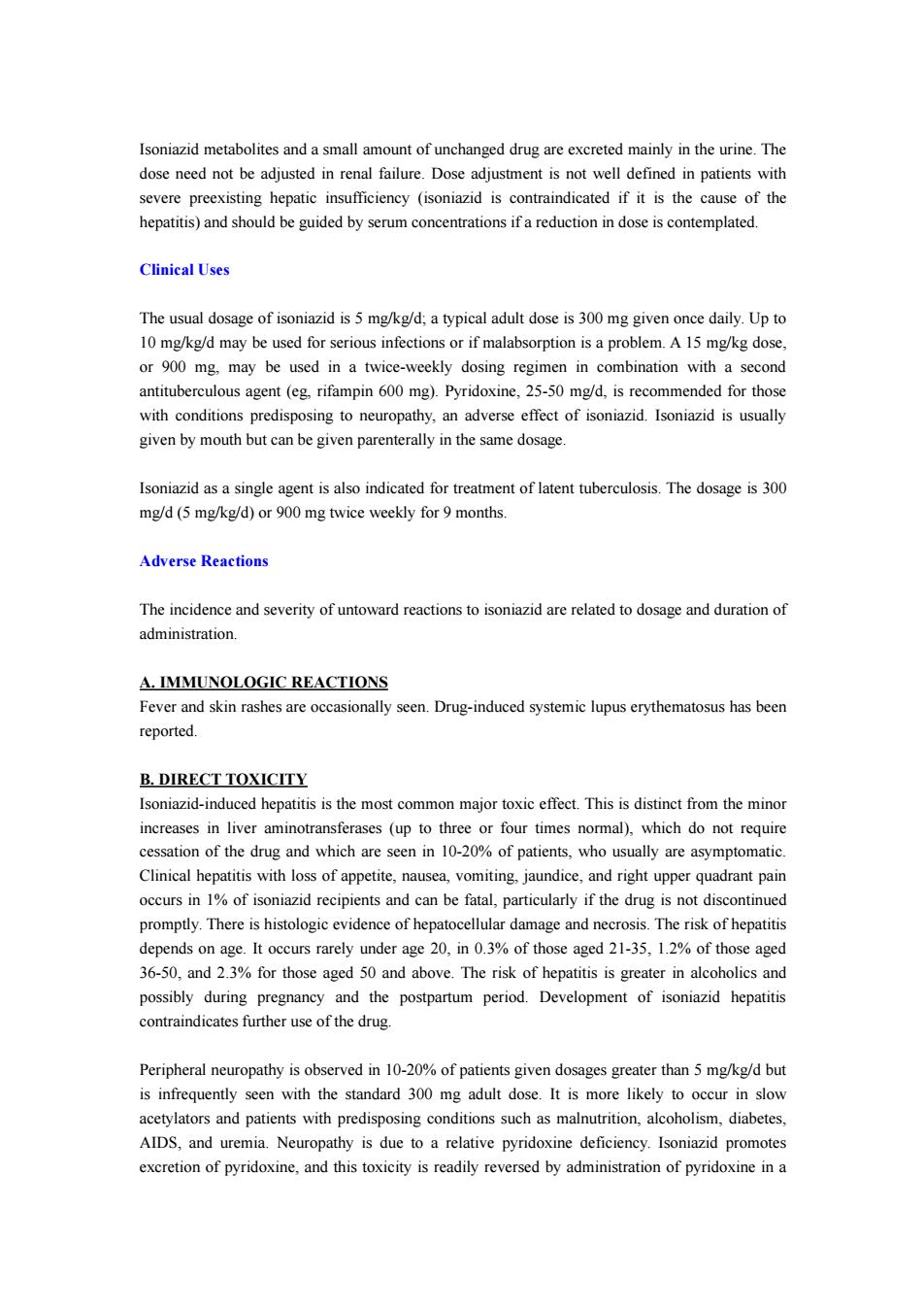正在加载图片...

Isoniazid metabolites and a small amount of unchanged drug are excreted mainly in the urine.The dose need not be adjusted in renal failure.Dose adjustment is not well defined in patients with severe preexisting hepatic insufficiency (isoniazid is contraindicated if it is the cause of the hepatitis)and should be guided by serum concentrations if a reduction in dose is contemplated. Clinical Uses The usual dosage of isoniazid is 5 mg/kg/d;a typical adult dose is 300 mg given once daily.Up to 10 mg/kg/d may be used for serious infections or if malabsorption is a problem.A 15 mg/kg dose, or 900 mg,may be used in a twice-weekly dosing regimen in combination with a second antituberculous agent (eg,rifampin 600 mg).Pyridoxine,25-50 mg/d,is recommended for those with conditions predisposing to neuropathy,an adverse effect of isoniazid.Isoniazid is usually given by mouth but can be given parenterally in the same dosage. Isoniazid as a single agent is also indicated for treatment of latent tuberculosis.The dosage is 300 mg/d(5 mg/kg/d)or 900 mg twice weekly for 9 months. Adverse Reactions The incidence and severity of untoward reactions to isoniazid are related to dosage and duration of administration. A.IMMUNOLOGIC REACTIONS Fever and skin rashes are occasionally seen.Drug-induced systemic lupus erythematosus has been reported. B.DIRECT TOXICITY Isoniazid-induced hepatitis is the most common major toxic effect.This is distinct from the minor increases in liver aminotransferases (up to three or four times normal),which do not require cessation of the drug and which are seen in 10-20%of patients,who usually are asymptomatic. Clinical hepatitis with loss of appetite,nausea,vomiting,jaundice,and right upper quadrant pain occurs in 1%of isoniazid recipients and can be fatal,particularly if the drug is not discontinued promptly.There is histologic evidence of hepatocellular damage and necrosis.The risk of hepatitis depends on age.It occurs rarely under age 20,in 0.3%of those aged 21-35,1.2%of those aged 36-50,and 2.3%for those aged 50 and above.The risk of hepatitis is greater in alcoholics and possibly during pregnancy and the postpartum period.Development of isoniazid hepatitis contraindicates further use of the drug. Peripheral neuropathy is observed in 10-20%of patients given dosages greater than 5 mg/kg/d but is infrequently seen with the standard 300 mg adult dose.It is more likely to occur in slow acetylators and patients with predisposing conditions such as malnutrition,alcoholism,diabetes, AIDS,and uremia.Neuropathy is due to a relative pyridoxine deficiency.Isoniazid promotes excretion of pyridoxine,and this toxicity is readily reversed by administration of pyridoxine in aIsoniazid metabolites and a small amount of unchanged drug are excreted mainly in the urine. The dose need not be adjusted in renal failure. Dose adjustment is not well defined in patients with severe preexisting hepatic insufficiency (isoniazid is contraindicated if it is the cause of the hepatitis) and should be guided by serum concentrations if a reduction in dose is contemplated. Clinical Uses The usual dosage of isoniazid is 5 mg/kg/d; a typical adult dose is 300 mg given once daily. Up to 10 mg/kg/d may be used for serious infections or if malabsorption is a problem. A 15 mg/kg dose, or 900 mg, may be used in a twice-weekly dosing regimen in combination with a second antituberculous agent (eg, rifampin 600 mg). Pyridoxine, 25-50 mg/d, is recommended for those with conditions predisposing to neuropathy, an adverse effect of isoniazid. Isoniazid is usually given by mouth but can be given parenterally in the same dosage. Isoniazid as a single agent is also indicated for treatment of latent tuberculosis. The dosage is 300 mg/d (5 mg/kg/d) or 900 mg twice weekly for 9 months. Adverse Reactions The incidence and severity of untoward reactions to isoniazid are related to dosage and duration of administration. A. IMMUNOLOGIC REACTIONS Fever and skin rashes are occasionally seen. Drug-induced systemic lupus erythematosus has been reported. B. DIRECT TOXICITY Isoniazid-induced hepatitis is the most common major toxic effect. This is distinct from the minor increases in liver aminotransferases (up to three or four times normal), which do not require cessation of the drug and which are seen in 10-20% of patients, who usually are asymptomatic. Clinical hepatitis with loss of appetite, nausea, vomiting, jaundice, and right upper quadrant pain occurs in 1% of isoniazid recipients and can be fatal, particularly if the drug is not discontinued promptly. There is histologic evidence of hepatocellular damage and necrosis. The risk of hepatitis depends on age. It occurs rarely under age 20, in 0.3% of those aged 21-35, 1.2% of those aged 36-50, and 2.3% for those aged 50 and above. The risk of hepatitis is greater in alcoholics and possibly during pregnancy and the postpartum period. Development of isoniazid hepatitis contraindicates further use of the drug. Peripheral neuropathy is observed in 10-20% of patients given dosages greater than 5 mg/kg/d but is infrequently seen with the standard 300 mg adult dose. It is more likely to occur in slow acetylators and patients with predisposing conditions such as malnutrition, alcoholism, diabetes, AIDS, and uremia. Neuropathy is due to a relative pyridoxine deficiency. Isoniazid promotes excretion of pyridoxine, and this toxicity is readily reversed by administration of pyridoxine in a